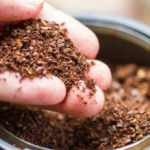If you’ve been dreaming of a low-maintenance, vibrant lawn that looks great year-round, clover seeds might just be your new best friend. Not only are clover_seeds eco-friendly and affordable, but they also offer numerous benefits that traditional grass simply can’t match. Whether you’re considering white clover_seeds, red clover_seeds, or even micro clover_seeds, there’s a perfect variety for every yard.
Because of their ability to enrich soil, resist drought, and reduce the need for synthetic fertilizers, more homeowners are turning to clover seeds for lawn transformations. This guide will cover everything — from the best time to plant to where to buy clover_seeds — and help you make an informed decision.
What Are Clover Seeds?
 Clover_seeds are tiny powerhouses that grow into vibrant clover plants, which belong to the legume family. These versatile clover_seeds come in several types, each offering its own set of unique benefits for lawns and gardens. Unlike traditional turfgrass, clover seeds produce plants that fix nitrogen from the air, naturally enriching the soil and promoting greener growth without the need for chemical fertilizers.
Clover_seeds are tiny powerhouses that grow into vibrant clover plants, which belong to the legume family. These versatile clover_seeds come in several types, each offering its own set of unique benefits for lawns and gardens. Unlike traditional turfgrass, clover seeds produce plants that fix nitrogen from the air, naturally enriching the soil and promoting greener growth without the need for chemical fertilizers.
Benefits of Planting Clover Seeds
There are countless reasons why people are choosing clover over grass. Here are just a few:
Environmentally Friendly
-
Reduces the need for synthetic fertilizers
-
Fixes nitrogen in the soil
-
Attracts pollinators like bees and butterflies
Cost-Effective
-
Requires less watering
-
Grows quickly and fills in bare spots
-
Needs less mowing than grass
Pet & Child Friendly
-
Soft to the touch and great for play areas
-
Safe for pets and doesn’t yellow with pet urine
Popular Types of Clover Seeds
When selecting the right seed, it’s essential to understand the varieties available:
1. White Clover Seeds
-
Most common type used for lawns
-
Stays low to the ground
-
Thrives in a variety of soil types
2. Red Clover Seeds
-
Taller than white clover
-
Often used as a cover crop
-
Improves soil health significantly
3. Crimson Clover Seeds
-
Bright red flowers make it ideal for aesthetics
-
Fast-growing cover crop
-
Adds nitrogen and organic matter
4. Micro Clover Seeds
-
Tiny leaves and low growth make it perfect for lawns
-
Blends seamlessly with grass
-
Very low maintenance and stays green longer
Each type offers its own set of benefits, so your choice should align with your lawn goals.
When to Plant Clover Seeds
Timing is crucial. So, when to plant clover_seeds for the best results?
-
Spring (Mid-April to Mid-May): Ideal for most climates.
-
Early Fall (Late August to Early October): Best for southern regions with mild winters.
-
Avoid planting during extreme heat or frost.
To ensure success:
-
Check soil temperature (between 50–65°F is ideal)
-
Avoid overly wet or dry conditions
-
Prepare the soil by raking and removing debris
How to Plant Clover Seeds Step-by-Step
Even if you’re not a green thumb, planting clover_seeds is pretty straightforward.
Step 1: Choose Your Clover Seed
Decide whether you want white, red, crimson, or micro clover_seeds. Match your choice to your goals—whether it’s aesthetic beauty, soil improvement, or ground cover.
Step-2: Prep the Soil
-
Mow existing grass low
-
Rake thoroughly to expose soil
-
Test soil pH (ideally 6.0–7.0)
Step 3: Spread the Seeds
-
Use a broadcast spreader for even coverage
-
Mix seeds with sand or soil for better visibility
-
Sow about 2 oz per 1,000 sq ft for lawns
Step 4: Water and Wait
-
Water immediately after planting
-
Keep soil moist until germination (about 7–14 days)
-
Limit foot traffic during early stages
Where to Buy Clover Seeds
If you’re wondering where to buy clover_seeds, you’re in luck — they’re easy to find both online and in local stores.
Online Options:
-
Amazon
-
Tractor Supply
-
Johnny’s Selected Seeds
-
Outsidepride.com
Local Options:
-
Home Depot
-
Lowe’s
-
Local garden centers
-
Co-op stores and nurseries
Just search “clover_seeds near me” and you’ll find plenty of choices based on your ZIP code.
Mixing Clover with Grass: Is It a Good Idea?
 Absolutely! Many homeowners mix micro clover_seeds with traditional turfgrass for a hybrid lawn that is lush, soft, and self-fertilizing.
Absolutely! Many homeowners mix micro clover_seeds with traditional turfgrass for a hybrid lawn that is lush, soft, and self-fertilizing.
Benefits of Mixing:
-
Keeps the look of a grass lawn
-
Reduces fertilizer usage
-
More drought resistant
Use a 5–10% micro clover to 90–95% grass seed ratio for best results.
Common Mistakes to Avoid
Even though clover is low-maintenance, some people make errors when planting. Here are a few things to watch out for:
-
Overwatering: Clover doesn’t need much once established
-
Planting in poor soil without prepping: Always rake and loosen the topsoil
-
Using too much seed: Can lead to overcrowding and patchy growth
-
Not mowing after blooming: Helps reset and maintain appearance
How Long Do Clover Seeds Take to Grow?
Germination typically occurs within 7 to 14 days, depending on temperature and moisture levels. Full coverage can take 4 to 6 weeks, and once established, your clover lawn will thrive with minimal effort.
Are Clover Lawns Good for Pollinators?
Yes! Clover flowers attract bees, butterflies, and other beneficial insects. If you’re eco-conscious, planting clover seeds is a great step toward supporting biodiversity in your backyard.
You can even mow around certain patches to let blooms grow freely for pollinator support.
Pros and Cons of Clover Seeds
Let’s break it down:
Pros:
-
Low maintenance
-
Self-fertilizing
-
Drought resistant
-
Supports pollinators
-
Soft underfoot
Cons:
-
May stain clothes
-
Can die back in extreme winters
-
Not ideal for high-traffic areas without grass mix
Transitioning From Grass to Clover Lawn
Making the switch is easy if you take it step-by-step. Start by:
-
Overseeding clover into existing grass
-
Reducing fertilizer use to let clover thrive
-
Mowing a bit higher to allow clover coverage
In just a season or two, you’ll have a lush, soft, and eco-friendly lawn that neighbors will admire.
Author Bio Table
| Name | The Green Thumb Writer |
|---|---|
| Expertise | Home gardening, lawn care, eco landscaping |
| Experience | 10+ years in organic and sustainable lawns |
| Published In | Garden Weekly, Eco Home, Green Living Today |
| Based In | Portland, Oregon |
| Hobbies | Seed collecting, DIY composting, native plants |
Final Thoughts
In conclusion, if you’re seeking a budget-friendly and eco-conscious way to enhance your outdoor space, clover_seeds offer the perfect solution. Not only do they reduce your dependence on fertilizers, but they also attract pollinators and resist drought naturally.
Moreover, whether you opt for white clover_seeds, red clover_seeds, or micro clover_seeds, you’ll benefit from lush ground cover that’s soft underfoot and visually pleasing. Even better, transitioning to a clover lawn takes less time and effort than you might expect.
Therefore, as you plan your next lawn upgrade, be sure to consider clover_seeds as a top-tier option. Ultimately, you’ll enjoy a greener, healthier, and more sustainable lawn — and your local environment will thank you for it.
FAQs
1. When is the best time to plant clover seeds?
Generally speaking, the best time to plant clover_seeds is in spring or early fall. Consequently, this timing allows the seeds to germinate in moderate temperatures with consistent moisture.
2. Can I plant clover seeds with grass?
Absolutely! In fact, mixing micro clover_seeds with grass is a popular choice. As a result, you get a hybrid lawn that’s self-fertilizing, lush, and low maintenance.
3. Are clover seeds safe for pets and children?
Without a doubt. Clover is soft, chemical-free, and urine-resistant, which means it’s an excellent ground cover for family-friendly yards.
4. Where can I buy clover seeds near me?
Luckily, you can find clover_seeds in most garden centers and home improvement stores. Additionally, online retailers like Amazon and Outsidepride offer convenient delivery.
5. What kind of clover is best for lawns?
In most cases, white clover_seeds and micro clover_seeds are ideal. They grow low, blend well with grass, and require very little upkeep.






